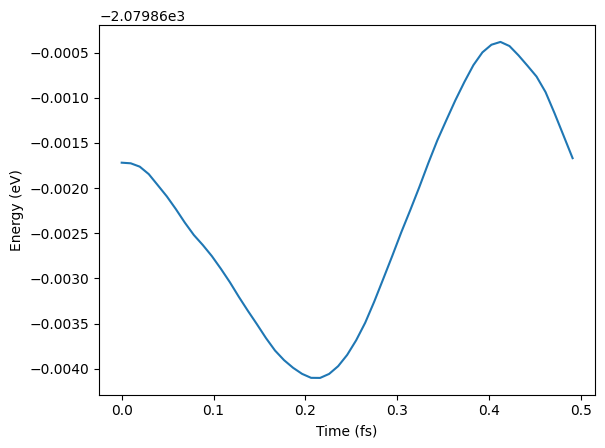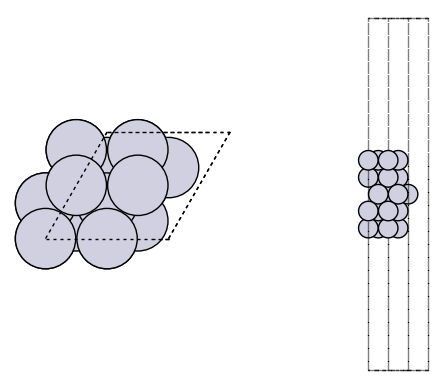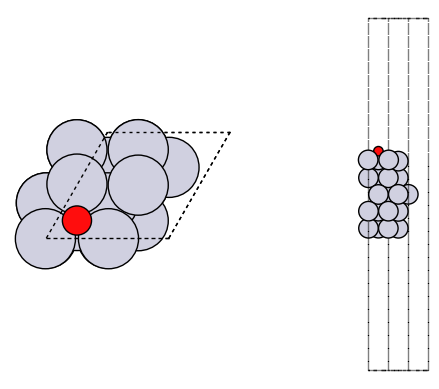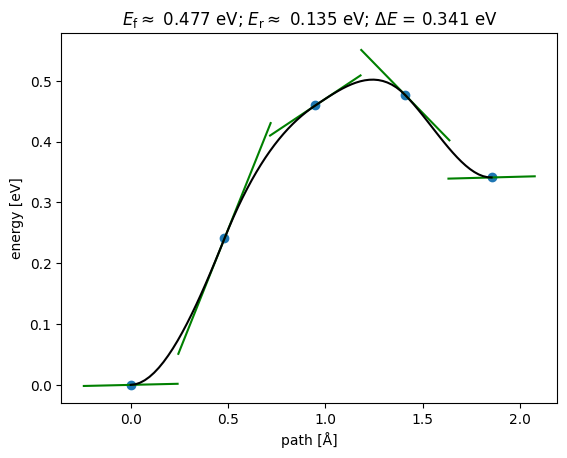UMA Intro Tutorial#
This tutorial will walk you through a few examples of how you can use UMA. Each step is covered in more detail elsewhere in the documentation, but this is well suited to a ~1-2 hour tutorial session for researchers new to UMA but with some background in ASE and molecular simulations.
Before you start / installation#
You need to get a HuggingFace account and request access to the UMA models.
You need a Huggingface account, request access to https://huggingface.co/facebook/UMA, and to create a Huggingface token at https://huggingface.co/settings/tokens/ with these permission:
Permissions: Read access to contents of all public gated repos you can access
Then, add the token as an environment variable (using huggingface-cli login:
# Enter token via huggingface-cli
! huggingface-cli login
or you can set the token via HF_TOKEN variable:
# Set token via env variable
import os
os.environ['HF_TOKEN'] = 'MYTOKEN'
Installation process#
It may be enough to use pip install fairchem-core. This gets you the latest version on PyPi (https://pypi.org/project/fairchem-core/)
Here we install some sub-packages. This can take 2-5 minutes to run.
! pip install fairchem-core fairchem-data-oc fairchem-applications-cattsunami x3dase
# Check that packages are installed
!pip list | grep fairchem
fairchem-applications-cattsunami 1.1.2.dev124+g27cbaa6e
fairchem-core 2.13.1.dev2+g27cbaa6e
fairchem-data-oc 1.0.3.dev124+g27cbaa6e
fairchem-data-omat 0.2.1.dev29+g27cbaa6e
import fairchem.core
fairchem.core.__version__
'2.13.1.dev2+g27cbaa6e'
Illustrative examples#
These should just run, and are here to show some basic uses.
Critical points:
Create a calculator
Specify the task_name
Use calculator like other ASE calculators
Spin gap energy - OMOL#
This is the difference in energy between a triplet and single ground state for a CH2 radical. This downloads a ~1GB checkpoint the first time you run it.
We don’t set a device here, so we get a warning about using a CPU device. You can ignore that. If a CUDA environment is available, a GPU may be used to speed up the calculations.
from fairchem.core import FAIRChemCalculator, pretrained_mlip
predictor = pretrained_mlip.get_predict_unit("uma-s-1")
WARNING:root:device was not explicitly set, using device='cuda'.
from ase.build import molecule
# singlet CH2
singlet = molecule("CH2_s1A1d")
singlet.info.update({"spin": 1, "charge": 0})
singlet.calc = FAIRChemCalculator(predictor, task_name="omol")
# triplet CH2
triplet = molecule("CH2_s3B1d")
triplet.info.update({"spin": 3, "charge": 0})
triplet.calc = FAIRChemCalculator(predictor, task_name="omol")
print(triplet.get_potential_energy() - singlet.get_potential_energy())
-0.5508372783660889
Example of adsorbate relaxation - OC20#
Here we just setup a Cu(100) slab with a CO on it and relax it.
This is an OC20 task because it is a slab with an adsorbate.
We specify an explicit device in the predictor here, and avoid the warning.
from ase.build import add_adsorbate, fcc100, molecule
from ase.optimize import LBFGS
from fairchem.core import FAIRChemCalculator, pretrained_mlip
predictor = pretrained_mlip.get_predict_unit("uma-s-1")
calc = FAIRChemCalculator(predictor, task_name="oc20")
# Set up your system as an ASE atoms object
slab = fcc100("Cu", (3, 3, 3), vacuum=8, periodic=True)
adsorbate = molecule("CO")
add_adsorbate(slab, adsorbate, 2.0, "bridge")
slab.calc = calc
# Set up LBFGS dynamics object
opt = LBFGS(slab)
opt.run(0.05, 100)
print(slab.get_potential_energy())
WARNING:root:device was not explicitly set, using device='cuda'.
Step Time Energy fmax
LBFGS: 0 05:47:33 -89.596203 11.451670
LBFGS: 1 05:47:33 -92.497567 6.543859
LBFGS: 2 05:47:33 -92.624425 7.536289
LBFGS: 3 05:47:33 -93.000903 3.716039
LBFGS: 4 05:47:33 -93.158681 3.480149
LBFGS: 5 05:47:33 -93.264146 2.256683
LBFGS: 6 05:47:34 -93.505240 1.133178
LBFGS: 7 05:47:34 -93.595930 0.991864
LBFGS: 8 05:47:34 -93.705349 0.683985
LBFGS: 9 05:47:34 -93.791539 0.506833
LBFGS: 10 05:47:34 -93.837925 0.364068
LBFGS: 11 05:47:34 -93.856804 0.349530
LBFGS: 12 05:47:34 -93.881769 0.498732
LBFGS: 13 05:47:34 -93.900195 0.433079
LBFGS: 14 05:47:34 -93.910014 0.156312
LBFGS: 15 05:47:34 -93.915884 0.169999
LBFGS: 16 05:47:34 -93.922146 0.211802
LBFGS: 17 05:47:35 -93.929013 0.260811
LBFGS: 18 05:47:35 -93.935161 0.183897
LBFGS: 19 05:47:35 -93.938070 0.057537
LBFGS: 20 05:47:35 -93.938498 0.039156
-93.9384984000145
Example bulk relaxation - OMAT#
from ase.build import bulk
from ase.filters import FrechetCellFilter
from ase.optimize import FIRE
from fairchem.core import FAIRChemCalculator, pretrained_mlip
predictor = pretrained_mlip.get_predict_unit("uma-s-1")
calc = FAIRChemCalculator(predictor, task_name="omat")
atoms = bulk("Fe")
atoms.calc = calc
opt = FIRE(FrechetCellFilter(atoms))
opt.run(0.05, 100)
print(atoms.get_stress()) # !!!! We get stress now!
WARNING:root:device was not explicitly set, using device='cuda'.
Step Time Energy fmax
FIRE: 0 05:47:38 -8.261158 0.651784
FIRE: 1 05:47:38 -8.271310 0.358118
FIRE: 2 05:47:38 -8.264588 1.650192
FIRE: 3 05:47:38 -8.273672 0.177968
FIRE: 4 05:47:38 -8.272634 0.269083
FIRE: 5 05:47:38 -8.272766 0.257552
FIRE: 6 05:47:38 -8.273009 0.234343
FIRE: 7 05:47:38 -8.273319 0.199201
FIRE: 8 05:47:38 -8.273635 0.151746
FIRE: 9 05:47:39 -8.273890 0.091454
FIRE: 10 05:47:39 -8.274016 0.017813
[ 1.5572989e-03 1.5573079e-03 1.5573259e-03 4.0535252e-08
-5.0974074e-09 4.2956039e-08]
Molecular dynamics - OMOL#
import matplotlib.pyplot as plt
from ase import units
from ase.build import molecule
from ase.io import Trajectory
from ase.md.langevin import Langevin
from fairchem.core import FAIRChemCalculator, pretrained_mlip
predictor = pretrained_mlip.get_predict_unit("uma-s-1")
calc = FAIRChemCalculator(predictor, task_name="omol")
atoms = molecule("H2O")
atoms.info.update(charge=0, spin=1) # For omol
atoms.calc = calc
dyn = Langevin(
atoms,
timestep=0.1 * units.fs,
temperature_K=400,
friction=0.001 / units.fs,
)
trajectory = Trajectory("my_md.traj", "w", atoms)
dyn.attach(trajectory.write, interval=1)
dyn.run(steps=50)
# See some results - not paper ready!
traj = Trajectory("my_md.traj")
plt.plot(
[i * 0.1 * units.fs for i in range(len(traj))],
[a.get_potential_energy() for a in traj],
)
plt.xlabel("Time (fs)")
plt.ylabel("Energy (eV)");
WARNING:root:device was not explicitly set, using device='cuda'.

Catalyst Adsorption energies#
The basic approach in computing an adsorption energy is to compute this energy difference:
dH = E_adslab - E_slab - E_ads
We use UMA for two of these energies E_adslab and E_slab. For E_ads We have to do something a little different. The OC20 task is not trained for molecules or molecular fragments. We use atomic energy reference energies instead. These are tabulated below.
The OC20 reference scheme is this reaction:
x CO + (x + y/2 - z) H2 + (z-x) H2O + w/2 N2 + * -> CxHyOzNw*
For this example we have
-H2 + H2O + * -> O*. "O": -7.204 eV
Where "O": -7.204 is a constant.
To get the desired reaction energy we want we add the formation energy of water. We use either DFT or experimental values for this reaction energy.
1/2O2 + H2 -> H2O
Alternatives to this approach are using DFT to estimate the energy of 1/2 O2, just make sure to use consistent settings with your task. You should not use OMOL for this.
from ase.build import add_adsorbate, fcc111
from ase.optimize import BFGS
from fairchem.core import FAIRChemCalculator, pretrained_mlip
predictor = pretrained_mlip.get_predict_unit("uma-s-1")
calc = FAIRChemCalculator(predictor, task_name="oc20")
WARNING:root:device was not explicitly set, using device='cuda'.
# reference energies from a linear combination of H2O/N2/CO/H2!
atomic_reference_energies = {
"H": -3.477,
"N": -8.083,
"O": -7.204,
"C": -7.282,
}
re1 = -3.03 # Water formation energy from experiment
slab = fcc111("Pt", size=(2, 2, 5), vacuum=20.0)
slab.pbc = True
adslab = slab.copy()
add_adsorbate(adslab, "O", height=1.2, position="fcc")
slab.calc = calc
opt = BFGS(slab)
print("Relaxing slab")
opt.run(fmax=0.05, steps=100)
slab_e = slab.get_potential_energy()
adslab.calc = calc
opt = BFGS(adslab)
print("\nRelaxing adslab")
opt.run(fmax=0.05, steps=100)
adslab_e = adslab.get_potential_energy()
Relaxing slab
Step Time Energy fmax
BFGS: 0 05:47:48 -104.710392 0.707696
BFGS: 1 05:47:48 -104.767890 0.605448
BFGS: 2 05:47:48 -104.919425 0.369265
BFGS: 3 05:47:48 -104.952878 0.441349
BFGS: 4 05:47:48 -105.030000 0.467592
BFGS: 5 05:47:48 -105.091451 0.365230
BFGS: 6 05:47:48 -105.128721 0.195045
BFGS: 7 05:47:49 -105.143315 0.048837
Relaxing adslab
Step Time Energy fmax
BFGS: 0 05:47:49 -110.055656 1.762239
BFGS: 1 05:47:49 -110.239039 0.996808
BFGS: 2 05:47:49 -110.389562 0.747533
BFGS: 3 05:47:49 -110.441195 0.818361
BFGS: 4 05:47:49 -110.557367 0.688425
BFGS: 5 05:47:49 -110.631215 0.497354
BFGS: 6 05:47:49 -110.687290 0.690800
BFGS: 7 05:47:49 -110.737890 0.729387
BFGS: 8 05:47:49 -110.774874 0.435697
BFGS: 9 05:47:49 -110.786663 0.199921
BFGS: 10 05:47:49 -110.789560 0.080701
BFGS: 11 05:47:50 -110.790038 0.057991
BFGS: 12 05:47:50 -110.790288 0.044009
Now we compute the adsorption energy.
# Energy for ((H2O-H2) + * -> *O) + (H2 + 1/2O2 -> H2O) leads to 1/2O2 + * -> *O!
adslab_e - slab_e - atomic_reference_energies["O"] + re1
-1.472972174389049
How did we do? We need a reference point. In the paper below, there is an atomic adsorption energy for O on Pt(111) of about -4.264 eV. This is for the reaction O + * -> O*. To convert this to the dissociative adsorption energy, we have to add the reaction:
1/2 O2 -> O D = 2.58 eV (expt)
to get a comparable energy of about -1.68 eV. There is about ~0.2 eV difference (we predicted -1.47 eV above, and the reference comparison is -1.68 eV) to account for. The biggest difference is likely due to the differences in exchange-correlation functional. The reference data used the PBE functional, and eSCN was trained on RPBE data. To additional places where there are differences include:
Difference in lattice constant
The reference energy used for the experiment references. These can differ by up to 0.5 eV from comparable DFT calculations.
How many layers are relaxed in the calculation
Some of these differences tend to be systematic, and you can calibrate and correct these, especially if you can augment these with your own DFT calculations.
It is always a good idea to visualize the geometries to make sure they look reasonable.
import matplotlib.pyplot as plt
from ase.visualize.plot import plot_atoms
fig, axs = plt.subplots(1, 2)
plot_atoms(slab, axs[0])
plot_atoms(slab, axs[1], rotation=("-90x"))
axs[0].set_axis_off()
axs[1].set_axis_off()

fig, axs = plt.subplots(1, 2)
plot_atoms(adslab, axs[0])
plot_atoms(adslab, axs[1], rotation=("-90x"))
axs[0].set_axis_off()
axs[1].set_axis_off()

Molecular vibrations#
from ase import Atoms
from ase.optimize import BFGS
predictor = pretrained_mlip.get_predict_unit("uma-s-1")
calc = FAIRChemCalculator(predictor, task_name="omol")
from ase.vibrations import Vibrations
n2 = Atoms("N2", [(0, 0, 0), (0, 0, 1.1)])
n2.info.update({"spin": 1, "charge": 0})
n2.calc = calc
BFGS(n2).run(fmax=0.01)
WARNING:root:device was not explicitly set, using device='cuda'.
Step Time Energy fmax
BFGS: 0 05:47:54 -2981.068009 1.645285
BFGS: 1 05:47:54 -2980.961841 6.601501
BFGS: 2 05:47:54 -2981.076753 0.203644
BFGS: 3 05:47:54 -2981.076882 0.024169
BFGS: 4 05:47:55 -2981.076883 0.000104
np.True_
vib = Vibrations(n2)
vib.run()
vib.summary()
---------------------
# meV cm^-1
---------------------
0 0.0i 0.0i
1 0.0i 0.0i
2 0.0 0.0
3 2.0 16.1
4 2.0 16.1
5 309.2 2494.2
---------------------
Zero-point energy: 0.157 eV
Bulk alloy phase behavior#
Adapted from https://kitchingroup.cheme.cmu.edu/dft-book/dft.html#orgheadline29
We manually compute the formation energy of pure compounds and some alloy compositions to assess stability.
from ase.atoms import Atom, Atoms
from ase.filters import FrechetCellFilter
from ase.optimize import FIRE
from fairchem.core import FAIRChemCalculator, pretrained_mlip
predictor = pretrained_mlip.get_predict_unit("uma-s-1")
cu = Atoms(
[Atom("Cu", [0.000, 0.000, 0.000])],
cell=[[1.818, 0.000, 1.818], [1.818, 1.818, 0.000], [0.000, 1.818, 1.818]],
pbc=True,
)
cu.calc = FAIRChemCalculator(predictor, task_name="omat")
opt = FIRE(FrechetCellFilter(cu))
opt.run(0.05, 100)
cu.get_potential_energy()
WARNING:root:device was not explicitly set, using device='cuda'.
Step Time Energy fmax
FIRE: 0 05:47:58 -3.756933 0.161999
FIRE: 1 05:47:58 -3.757594 0.110083
FIRE: 2 05:47:58 -3.758130 0.020766
-3.7581302158088254
pd = Atoms(
[Atom("Pd", [0.000, 0.000, 0.000])],
cell=[[1.978, 0.000, 1.978], [1.978, 1.978, 0.000], [0.000, 1.978, 1.978]],
pbc=True,
)
pd.calc = FAIRChemCalculator(predictor, task_name="omat")
opt = FIRE(FrechetCellFilter(pd))
opt.run(0.05, 100)
pd.get_potential_energy()
Step Time Energy fmax
FIRE: 0 05:47:58 -5.211726 0.240058
FIRE: 1 05:47:58 -5.213070 0.131577
FIRE: 2 05:47:58 -5.213503 0.060259
FIRE: 3 05:47:58 -5.213528 0.051645
FIRE: 4 05:47:58 -5.213565 0.035871
-5.213564711544393
Alloy formation energies#
cupd1 = Atoms(
[Atom("Cu", [0.000, 0.000, 0.000]), Atom("Pd", [-1.652, 0.000, 2.039])],
cell=[[0.000, -2.039, 2.039], [0.000, 2.039, 2.039], [-3.303, 0.000, 0.000]],
pbc=True,
) # Note pbc=True is important, it is not the default and OMAT
cupd1.calc = FAIRChemCalculator(predictor, task_name="omat")
opt = FIRE(FrechetCellFilter(cupd1))
opt.run(0.05, 100)
cupd1.get_potential_energy()
Step Time Energy fmax
FIRE: 0 05:47:59 -9.202820 0.142030
FIRE: 1 05:47:59 -9.203042 0.127498
FIRE: 2 05:47:59 -9.203371 0.101174
FIRE: 3 05:47:59 -9.203669 0.068563
FIRE: 4 05:47:59 -9.203892 0.060712
FIRE: 5 05:47:59 -9.204129 0.078850
FIRE: 6 05:47:59 -9.204490 0.081599
FIRE: 7 05:47:59 -9.204987 0.069264
FIRE: 8 05:47:59 -9.205592 0.045645
-9.205591614980058
cupd2 = Atoms(
[
Atom("Cu", [-0.049, 0.049, 0.049]),
Atom("Cu", [-11.170, 11.170, 11.170]),
Atom("Pd", [-7.415, 7.415, 7.415]),
Atom("Pd", [-3.804, 3.804, 3.804]),
],
cell=[[-5.629, 3.701, 5.629], [-3.701, 5.629, 5.629], [-5.629, 5.629, 3.701]],
pbc=True,
)
cupd2.calc = FAIRChemCalculator(predictor, task_name="omat")
opt = FIRE(FrechetCellFilter(cupd2))
opt.run(0.05, 100)
cupd2.get_potential_energy()
Step Time Energy fmax
FIRE: 0 05:47:59 -18.126594 0.181633
FIRE: 1 05:47:59 -18.127546 0.162953
FIRE: 2 05:48:00 -18.129066 0.127294
FIRE: 3 05:48:00 -18.130534 0.078069
FIRE: 4 05:48:00 -18.131346 0.021484
-18.13134633687845
# Delta Hf cupd-1 = -0.11 eV/atom
hf1 = (
cupd1.get_potential_energy() - cu.get_potential_energy() - pd.get_potential_energy()
)
hf1
-0.23389668762683957
# DFT: Delta Hf cupd-2 = -0.04 eV/atom
hf2 = (
cupd2.get_potential_energy()
- 2 * cu.get_potential_energy()
- 2 * pd.get_potential_energy()
)
hf2
-0.1879564821720141
hf1 - hf2, (-0.11 - -0.04)
(-0.04594020545482547, -0.07)
These indicate that cupd-1 and cupd-2 are both more stable than phase separated Cu and Pd, and that cupd-1 is more stable than cupd-2. The absolute formation energies differ from the DFT references, but the relative differences are quite close. The absolute differences could be due to DFT parameter choices (XC, psp, etc.).
Phonon calculation#
This takes 4-10 minutes. Adapted from https://wiki.fysik.dtu.dk/ase/ase/phonons.html#example.
Phonons have applications in computing the stability and free energy of solids. See:
https://www.sciencedirect.com/science/article/pii/S1359646215003127
https://iopscience.iop.org/book/mono/978-0-7503-2572-1/chapter/bk978-0-7503-2572-1ch1
from ase.build import bulk
from ase.phonons import Phonons
predictor = pretrained_mlip.get_predict_unit("uma-s-1")
calc = FAIRChemCalculator(predictor, task_name="omat")
# Setup crystal
atoms = bulk("Al", "fcc", a=4.05)
# Phonon calculator
N = 7
ph = Phonons(atoms, calc, supercell=(N, N, N), delta=0.05)
ph.run()
# Read forces and assemble the dynamical matrix
ph.read(acoustic=True)
ph.clean()
path = atoms.cell.bandpath("GXULGK", npoints=100)
bs = ph.get_band_structure(path)
dos = ph.get_dos(kpts=(20, 20, 20)).sample_grid(npts=100, width=1e-3)
WARNING:root:device was not explicitly set, using device='cuda'.
WARNING, 2 imaginary frequencies at q = ( 0.00, 0.00, 0.00) ; (omega_q = 6.044e-09*i)
WARNING, 2 imaginary frequencies at q = ( 0.00, 0.00, 0.00) ; (omega_q = 6.044e-09*i)
# Plot the band structure and DOS:
import matplotlib.pyplot as plt # noqa
fig = plt.figure(figsize=(7, 4))
ax = fig.add_axes([0.12, 0.07, 0.67, 0.85])
emax = 0.04
bs.plot(ax=ax, emin=0.0, emax=emax)
dosax = fig.add_axes([0.8, 0.07, 0.17, 0.85])
dosax.fill_between(
dos.get_weights(),
dos.get_energies(),
y2=0,
color="grey",
edgecolor="k",
lw=1,
)
dosax.set_ylim(0, emax)
dosax.set_yticks([])
dosax.set_xticks([])
dosax.set_xlabel("DOS", fontsize=18);

Transition States (NEBs)#
Nudged elastic band calculations are among the most costly calculations we do. UMA makes these quicker!
Get initial state
Get final state
Construct band and interpolate the images
Relax the band
Analyze and plot the band.
We explore diffusion of an O adatom from an hcp to an fcc site on Pt(111).
Initial state#
from ase.build import add_adsorbate, fcc111, molecule
from ase.optimize import LBFGS
from fairchem.core import FAIRChemCalculator, pretrained_mlip
predictor = pretrained_mlip.get_predict_unit("uma-s-1")
calc = FAIRChemCalculator(predictor, task_name="oc20")
# Set up your system as an ASE atoms object
initial = fcc111("Pt", (3, 3, 3), vacuum=8, periodic=True)
adsorbate = molecule("O")
add_adsorbate(initial, adsorbate, 2.0, "fcc")
initial.calc = calc
# Set up LBFGS dynamics object
opt = LBFGS(initial)
opt.run(0.05, 100)
print(initial.get_potential_energy())
WARNING:root:device was not explicitly set, using device='cuda'.
Step Time Energy fmax
LBFGS: 0 05:48:09 -141.329799 3.509945
LBFGS: 1 05:48:09 -141.719928 3.515035
LBFGS: 2 05:48:09 -142.980942 2.978368
LBFGS: 3 05:48:09 -143.684057 0.968204
LBFGS: 4 05:48:09 -143.787053 1.271678
LBFGS: 5 05:48:09 -143.858780 0.874630
LBFGS: 6 05:48:09 -143.933924 0.170922
LBFGS: 7 05:48:09 -143.937116 0.152460
LBFGS: 8 05:48:09 -143.944594 0.122234
LBFGS: 9 05:48:09 -143.948828 0.109295
LBFGS: 10 05:48:09 -143.952234 0.069970
LBFGS: 11 05:48:09 -143.953716 0.080108
LBFGS: 12 05:48:10 -143.955175 0.083488
LBFGS: 13 05:48:10 -143.956802 0.066264
LBFGS: 14 05:48:10 -143.958313 0.031494
-143.95831325644622
Final state#
# Set up your system as an ASE atoms object
final = fcc111("Pt", (3, 3, 3), vacuum=8, periodic=True)
adsorbate = molecule("O")
add_adsorbate(final, adsorbate, 2.0, "hcp")
final.calc = FAIRChemCalculator(predictor, task_name="oc20")
# Set up LBFGS dynamics object
opt = LBFGS(final)
opt.run(0.05, 100)
print(final.get_potential_energy())
Step Time Energy fmax
LBFGS: 0 05:48:10 -141.282604 3.340431
LBFGS: 1 05:48:10 -141.659791 3.323329
LBFGS: 2 05:48:10 -142.891404 2.596618
LBFGS: 3 05:48:10 -143.418901 1.225933
LBFGS: 4 05:48:10 -143.484099 0.977169
LBFGS: 5 05:48:10 -143.606341 0.136691
LBFGS: 6 05:48:10 -143.610842 0.118671
LBFGS: 7 05:48:10 -143.613319 0.100146
LBFGS: 8 05:48:11 -143.615010 0.078482
LBFGS: 9 05:48:11 -143.616456 0.051591
LBFGS: 10 05:48:11 -143.617143 0.033145
-143.6171429454721
Setup and relax the band#
from ase.mep import NEB
images = [initial]
for i in range(3):
image = initial.copy()
image.calc = FAIRChemCalculator(predictor, task_name="oc20")
images.append(image)
images.append(final)
neb = NEB(images)
neb.interpolate()
opt = LBFGS(neb, trajectory="neb.traj")
opt.run(0.05, 100)
Step Time Energy fmax
LBFGS: 0 05:48:11 -143.193978 3.039291
LBFGS: 1 05:48:11 -143.360197 1.460897
LBFGS: 2 05:48:11 -143.411349 0.450290
LBFGS: 3 05:48:12 -143.423401 0.447563
LBFGS: 4 05:48:12 -143.443053 0.476383
LBFGS: 5 05:48:12 -143.459314 0.378496
LBFGS: 6 05:48:13 -143.469905 0.211686
LBFGS: 7 05:48:13 -143.474787 0.177275
LBFGS: 8 05:48:13 -143.475807 0.183700
LBFGS: 9 05:48:13 -143.477289 0.178488
LBFGS: 10 05:48:14 -143.478788 0.167183
LBFGS: 11 05:48:14 -143.479388 0.094902
LBFGS: 12 05:48:14 -143.479540 0.096951
LBFGS: 13 05:48:14 -143.479792 0.100282
LBFGS: 14 05:48:15 -143.480348 0.124768
LBFGS: 15 05:48:15 -143.481010 0.092786
LBFGS: 16 05:48:15 -143.481433 0.050534
LBFGS: 17 05:48:15 -143.481731 0.040595
np.True_
from ase.mep import NEBTools
NEBTools(neb.images).plot_band();

This could be a good initial guess to initialize an NEB in DFT.
Ideas for things you can do with UMA#
FineTuna - use it for initial geometry optimizations then do DFT
a. https://iopscience.iop.org/article/10.1088/2632-2153/ac8fe0
b. https://iopscience.iop.org/article/10.1088/2632-2153/ad37f0
AdsorbML - prescreen adsorption sites to find relevant ones
a. https://www.nature.com/articles/s41524-023-01121-5
CatTsunami - screen NEBs more thoroughly
a. https://pubs.acs.org/doi/10.1021/acscatal.4c04272
Free energy estimations - compute vibrational modes and use them to estimate vibrational entropy
a. https://pubs.acs.org/doi/10.1021/acs.jpcc.4c07477
Massive screening of catalyst surface properties (685M relaxations)
a. https://arxiv.org/abs/2411.11783
Advanced applications#
These take a while to run.
AdsorbML#
It is so cheap to run these calculations that we can screen a broad range of adsorbate sites and rank them in stability. The AdsorbML approach automates this. This takes quite a while to run here, and we don’t do it in the workshop.
Expert adsorption energies#
This tutorial reproduces Fig 6b from the following paper: Zhou, Jing, et al. “Enhanced Catalytic Activity of Bimetallic Ordered Catalysts for Nitrogen Reduction Reaction by Perturbation of Scaling Relations.” ACS Catalysis 134 (2023): 2190-2201 (https://doi.org/10.1021/acscatal.2c05877).
This takes up to an hour with a GPU, and much longer with a CPU.
CatTsunami#
The CatTsunami tutorial is an example of enumerating initial and final states, and computing reaction paths between them with UMA.
Acknowledgements#
This tutorial was originally compiled by John Kitchin (CMU) for the NAM29 catalysis tutorial session, using a variety of resources from the FAIR chemistry repository.
